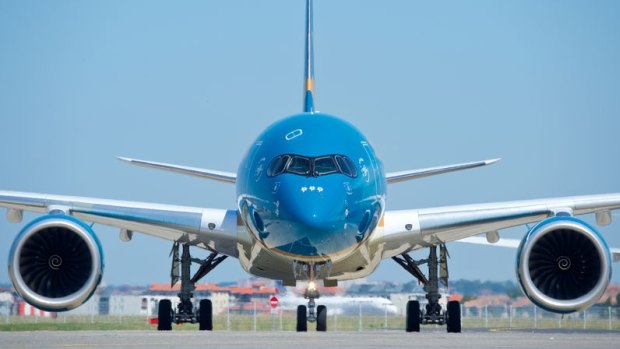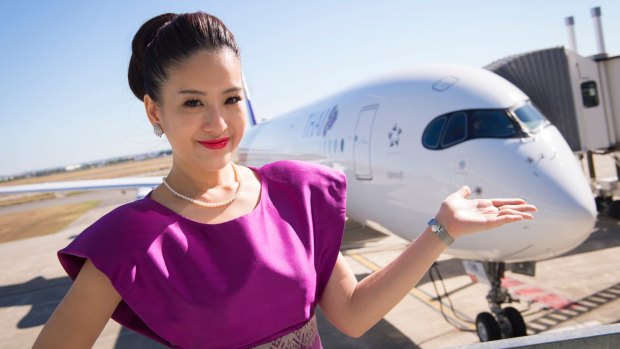This was published 7 years ago
Airbus A350 XWB vs Boeing 787 Dreamliner: Which new long-haul carrier is best?
By Michael Gebicki
There's a shootout happening in the skies, with two competing aircraft that promise a new era in long-haul passenger comfort and a game-changer for airlines. In one corner is Boeing's 787 Dreamliner, in the other the Airbus A350 XWB.
There are major similarities. They're both long range, wide-bodied, twin-engine aircraft. Both are the first large commercial aircraft to be constructed extensively from carbon fibre reinforced polymer (CFRP), which doesn't corrode or suffer from fatigue to the same extent as a traditional aluminium fuselage and wings. CFRP also allows the cabin to tolerate higher pressure. The pressure inside the cabin of the 787 Dreamliner and A350 XWB is equivalent to about 6000 feet, about 2000 feet lower than aboard a conventional aircraft, which means more oxygen in your lungs, more moisture in the air and a more comfortable flight. Both use LED lighting systems in the cabins, which are softer on the eyes and allow an airline to customise the lighting according to the time of day, or to mate with its brand colours.
The Airbus A350-900, the most popular of the three A350 variants, carries 325 passengers in a typical three-class configuration while Boeing's 787-9, the most recent iteration of the four-type 787 family, seats 280 in the same configuration. Range for the A350 is 15,000 kilometres, 14,140 kilometres for the Boeing 787.

Vietnam Airlines is one of the airlines to operate the impressive Airbus A350 XWB.
List price for the Airbus A350-900 is $US308.1 million ($400 million) against $US264.6 million for the Boeing 787-9. The appeal for airlines is their cost effectiveness. Both aircraft offer a big saving in fuel costs relative to the number of passengers they carry. They're workhorses, with durable airframes and low maintenance costs.
There are also differences, in the way their CFRP bodies are assembled and in their systems architecture, and here the Boeing breaks new ground with its use of electrical systems to control flaps, rudder, elevators etc, instead of the hydraulic systems found on traditional commercial aircraft including the Airbus A350 XWB. The total electrical power generated on a Boeing 787 is 1.45 megawatts, about five times greater than aboard a conventional commercial aircraft. This represents an evolutionary step in commercial aviation but it comes with teething problems.
Boeing developed powerful new lithium-ion batteries for the 787, which pack a big punch relative to their mass, but they're prone to pyrotechnics. In 2013 the US Federal Aviation Administration grounded the entire 787 fleet of US-based carriers for six months after fires broke out on ANA and JAL 787s, caused by lithium-ion batteries.

The Airbus A350 XWB aircraft for Thai Airways boasts supersize overhead bins.
Windows on the Boeing are larger, 65 per cent bigger than a standard airline window, but they're different from those on the Airbus. Boeing opted for electro-chromatic dimmable windows, a fancy name for windows that dim via a switch. Great idea but even at its darkest setting, these windows remain translucent. Sleeping or watching a movie when it's full daylight outside is slightly less satisfying than in a fully darkened cabin, which is what you get when conventional window shades are all closed. Another problem, the Boeing windows don't block heat as effectively as a pull-down shade and despite the freezing temperatures outside, windows can become hot to the touch. For all those reasons some airlines have retro-fitted pull-down blinds over their Boeing's windows. The Airbus A350 XWB relies on the tried-and-tested pull-down blinds to darken its windows, and yes they're big, although not so large as the Boeing's.
The Airbus A350 XWB has one of the quietest cabins in the skies thanks largely to the Rolls Royce Trent XWB, the only engine available for the Airbus. Typical ambient noise level in the cabin at cruising altitude is 57 decibels, about equal to the volume of a normal conversation. Only the Airbus A380 has a quieter cabin.
The A350 XWB has the tallest ceiling of any commercial aircraft and supersize overhead bins. According to Airbus, every passenger can travel with a carry-on bag of maximum dimensions, which should ensure that even the last passengers to board a full cabin should find ample stowage space.
Seating in economy class cabins on both is typically 3-3-3. Cabin width is 5.49 metres aboard the Boeing 787 as opposed to 5.61 metres on the Airbus A350. While those 11 centimetres might not sound like much they allow Airbus to install seats 45.7cm wide, about 2.5cm more than the standard-width seats featured on the Boeing. Squishy seats is a complaint frequently heard from economy-class passengers and the problem lies with the seat width – which also affects shoulder room. Again a small difference but it adds up to a lot of extra comfort on a long-haul flight.
The Airbus is the first aircraft to feature fourth generation inflight entertainment. Video screens are wide, typically 28cm in economy, and there's a big pay-off in leg room. Instead of those chunky metal boxes on the floor under the seat in front, the curse of long-legged passengers, there's just a slim unit that makes a compact bulge in one of the seat legs.
Finally, the tail camera. The Airbus has it, the Boeing doesn't. Watching the world below unfurl like a magic carpet is at least as good as the inflight entertainment.
Both aircraft offer a leap in passenger comfort. Given a choice of economy-class travel, the quieter cabin, wider seat, fourth gen inflight entertainment system, bigger overhead bins and full-dark cabin give the Airbus A350 XWB the edge in my book.
Who flies Boeing 787 Dreamliners and Airbus A350 XWB aircraft in Australia's skies?
Boeing 787 Dreamliner:
Jetstar: See flight test
Air New Zealand: See flight test
United Airlines: See flight test
Scoot Airlines: See flight test
Thai Airways (Take a look inside in the gallery above)
LATAM: See flight test
Vietnam Airlines (from late October)
Airbus A350 XWB:
Thai Airways (from September 16): See Australian city first to welcome Thai Airways brand new Airbus A350
Qatar Airways
Vietnam Airlines
Singapore Airlines: See Singapore's first A350 arrives in Australia for the first time
Sign up for the Traveller newsletter
The latest travel news, tips and inspiration delivered to your inbox. Sign up now.